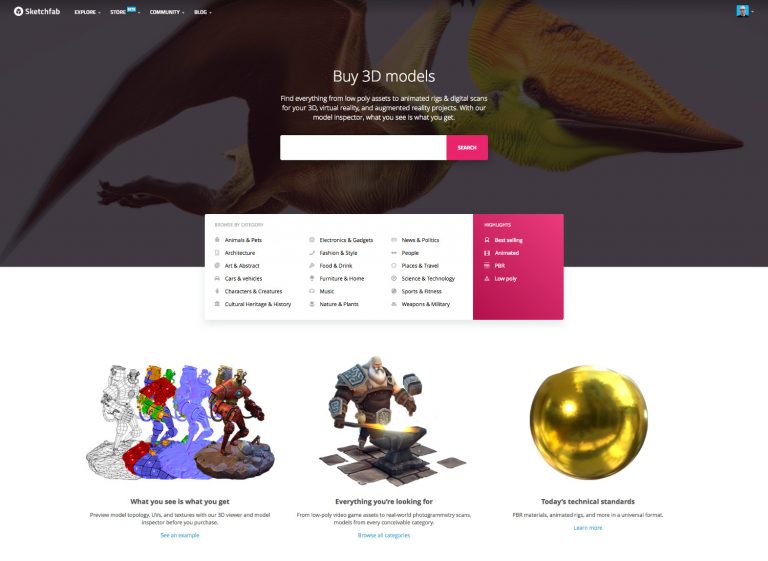Sketchfab has followed the money and beta launched the Sketchfab Store, an online platform where users can buy and sell 3D models and designs.
3D Printing Industry caught up with Sketchfab CEO Alban Denoyel to learn more about this new direction and future plans for the platform.
Sketchfab previously gave users the option of making their 3D objects downloadable for free, licensed under Creative Commons (CC). Sketchfab describe this new turn as a “natural evolution” to guarantee its “success as a platform.”
Sketchfab has argued that it needs to both “help creators monetize their creations” and to fulfill its broader aim to “distribute 3D content everywhere” by “distributing it outside Sketchfab.”
The decision to monetize
Sketchfab’s decision to monetize with a store comes at a time when the user base has amassed over one million members and two million 3D files, concurrent with a growing market for VR and AR compatible devices.
“Our initial goal was to let people publish, share and discover 3D content everywhere,” said Denoyel. “The store component means that this content will be distributed more broadly, because even outside of the Sketchfab ecosystem.”

How the Sketchfab Store works
Sketchfab users who want their creations featured in the Sketchfab Store must apply for a Seller account. Only existing Sketchfab accounts with 10 or more uploaded models will be considered in applications.
During this process, a user’s portfolio is reviewed against criteria such including whether including “all models, textures, and/or animations are your original property” and whether “models specifically sold for 3D printing are water-tight and appropriately constructed.”
Payment can then be processed by linking a PayPal account. All transactions are subject Sketchfab’s commission is 30% and potential PayPal fees. In comparison, marketplaces like CGTrader charge 10% fees, while others like Pinshape charge on a pay-per-design basis.
The benefits of selling on Sketchfab
Sketchfab has argued that the “growing need and market for 3D assets” and the further mainstream emergence of “VR and AR” further justifies a platform where 3D designs can be bought and sold. According to Denoyel, the Sketchfab Store has been well received by its community and was one of the “most requested features.”
To encourage selling on the platform, Sketchfab processes all files that are up for sale and offers lets customers see the full anatomy of a model and observe all technical information about the file prior to finalizing a purchase.
Sketchfab also boasts interoperable format, including a Unity importer to render objects consistently in engines like Unity or Unreal, while the store is constantly curated, and suggested similar models are shown in a sidebar (like the related videos option in Youtube).

A smooth road ahead?
There are a number of questions about Sketchfab’s road to monetization. Sketchfab launched its option to download 3D objects under CC licensing in 2014. Some of the downloadable objects are scanned heritage pieces and artworks. Denoyel, however, said that “if those users want to monetize their content they will need to pick a commercial license, thus leave the CC framework.”
Secondly, Sketchfab now faces increased competition in the free 3D object marketplace from Google Poly and Microsoft Remix3d. On this, Denoyel was not so worried, commenting that,
“It’s generally a good thing for an ecosystem to have more players, the moves by Google and Microsoft are a good validation that we’ve been on the right path from day one.”
However, Denoyel stated that Sketchfab has the edge with its independent platform, 150,000 freely downloadable objects and support for AR and VR.
He also questioned the group creativity that the likes of Google and Microsoft will foster on their platforms, noting that “typically a lot of their content is populated by themselves, which is a surprising way of growing a community.”
Finally, the vast majority of objects on the Sketchfab store cannot be 3D printed, begging the question as to how the company expects to keep up with the increasing popularity of 3D printing.
Denoyel replied that while Sketchfab tried to make more objects 3D printable, a lack of bandwidth and demand stopped it in its tracks. “We know a lot of museums publish printable content on Sketchfab, and a lot of people print them,” Denoyel said. “For now we are happy to see this happen organically but don’t really have the resources to invest in that.”
Make your nominations for the 3D Printing Industry Awards 2018 now.
For more stories on 3D software, subscribe to our free 3D Printing Industry newsletter, follow us on Twitter, and like us on Facebook.
Featured image shows a Tupuxuara Leonardii Flight Cycle 3D model on Sketchfab. Image via Sketchfab.


